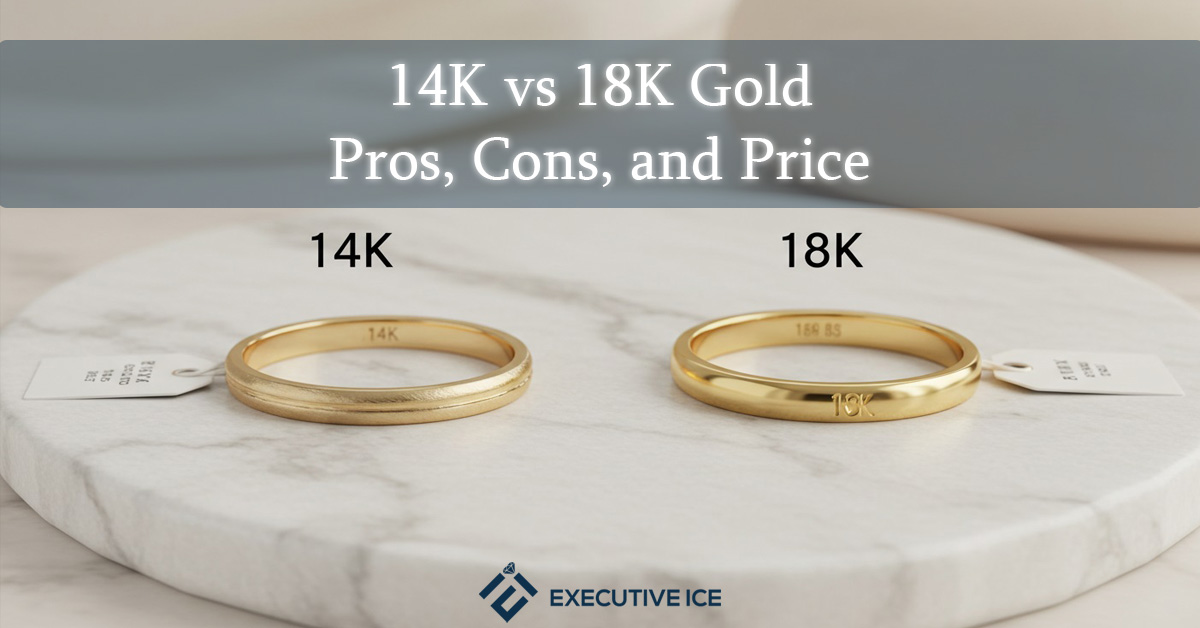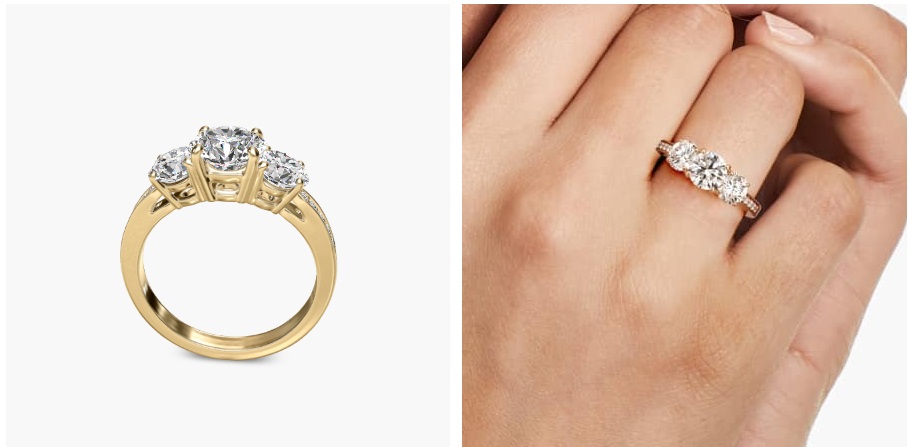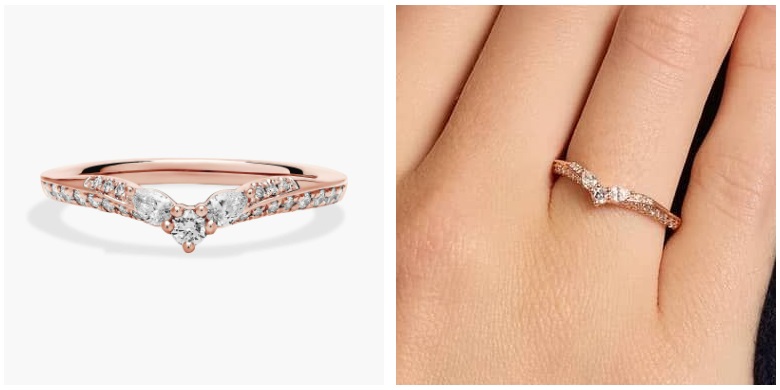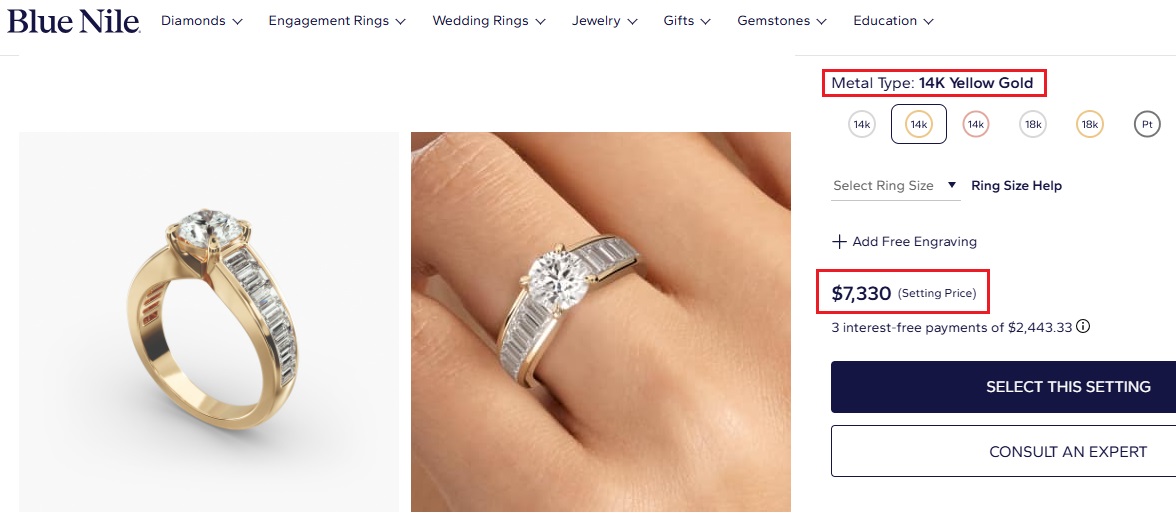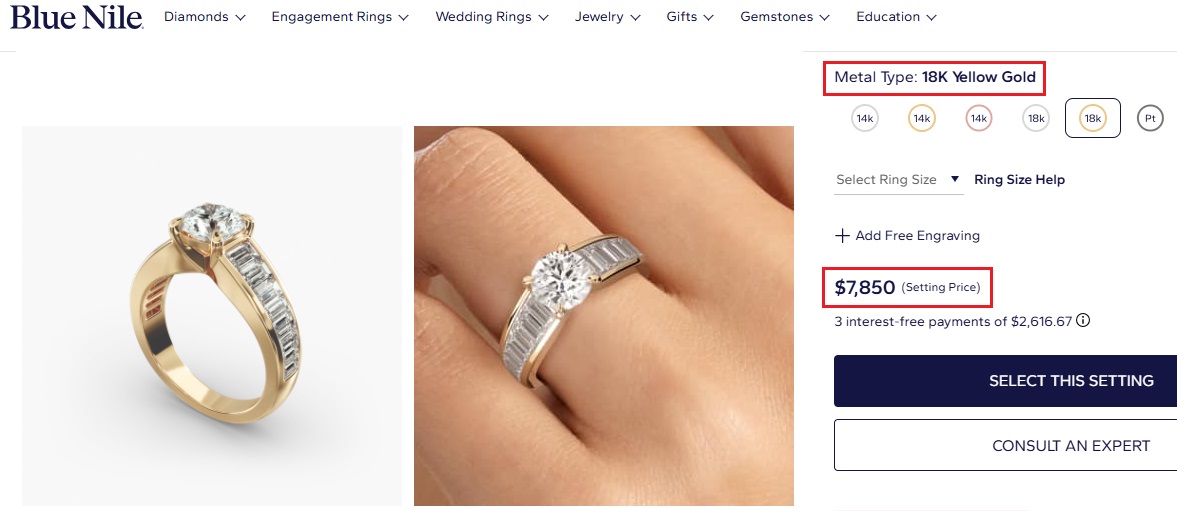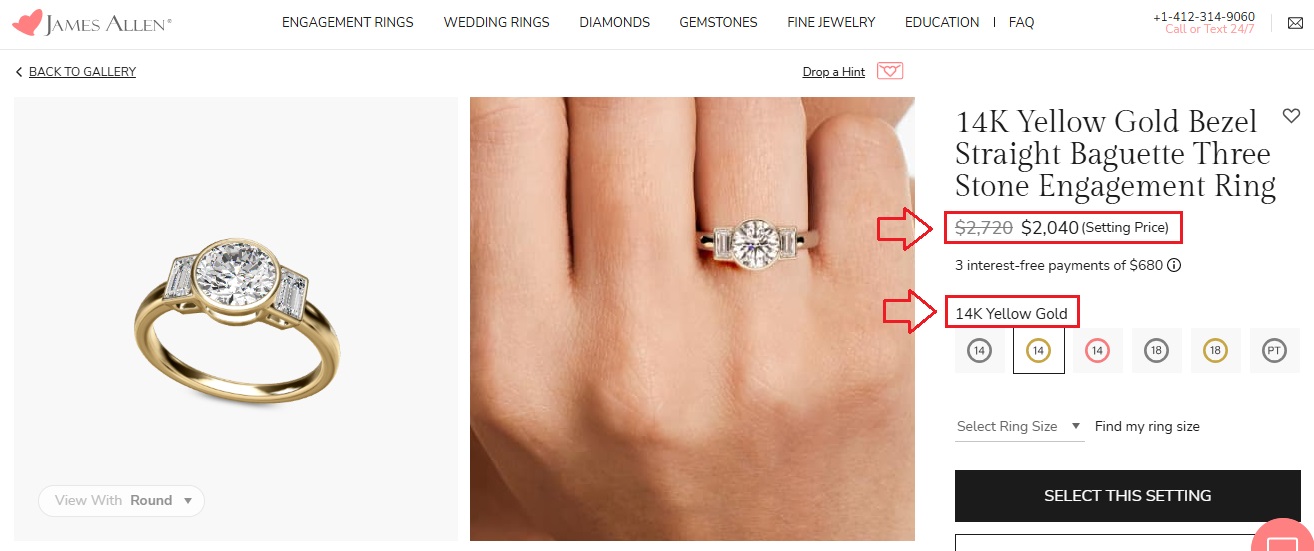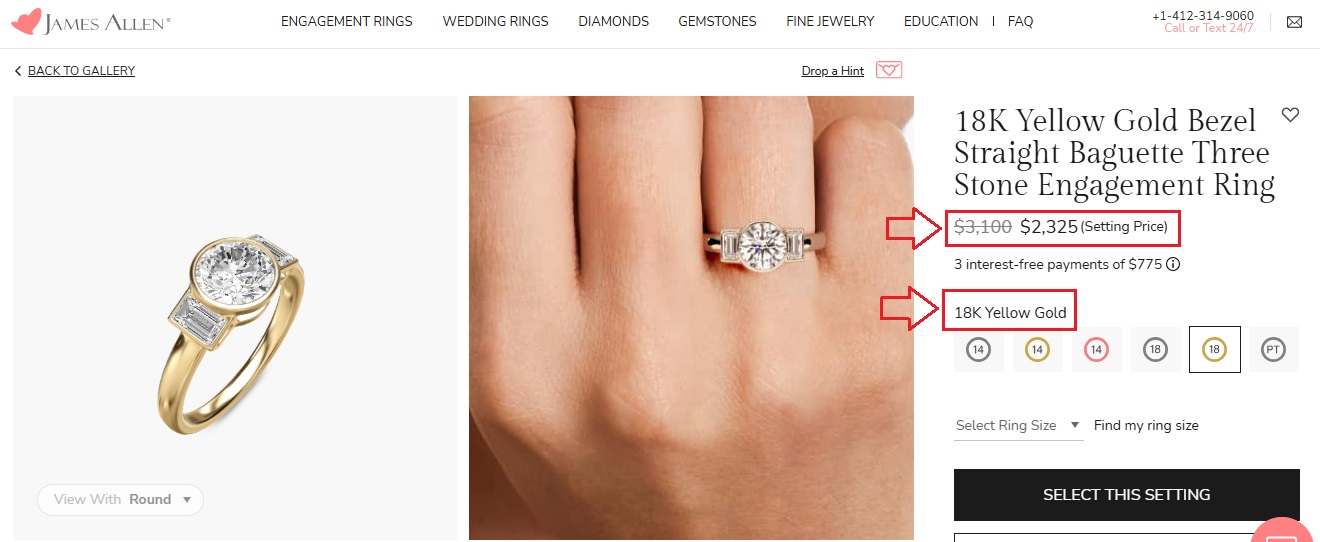14K vs 18K Gold might sound like a small difference, but when you’re picking out a piece of jewelry, like a ring, chain, or bracelet, it can actually matter a lot.
These two gold types don’t just vary in price; they also feel different, wear differently over time, and even look slightly different in color.
➡ In this article:
You’ll learn exactly what sets 14K and 18K gold apart, from how much pure gold they contain to how they hold up with daily wear.
➡ We’ll also walk through:
The pros and cons of each, how they compare in cost, and which one might be the better fit for your lifestyle and budget.
What Does Karat Mean in Gold?
When you see “14K” or “18K” on a piece of gold jewelry, that little “K” stands for karat—a way to measure how much pure gold is in the piece.
Gold is a soft metal, so it’s usually mixed with stronger metals (like copper, silver, or zinc) to make it more durable.
Karats tell you how much of the metal is real gold, out of 24 parts.
- 14K gold means it’s made of 14 parts pure gold and 10 parts other metals, so it’s 58.3% pure gold.
- 18K gold means 18 parts gold and 6 parts other metals, so it’s 75% pure gold.

The higher the karat number, the more gold it contains.
But more gold doesn’t always mean better, it depends on what you want.
That’s where things like price, color, and durability come in (and we’ll cover all of that next).
Gold Purity: 14K vs 18K Breakdown
Now that we know what karat means, let’s take a closer look at 14K vs 18K gold in terms of purity and what that actually changes.
-
14K Gold = 58.3% Pure Gold
That means more than 40% of the metal is made up of stronger metals like copper, nickel, or silver.
👉 This makes 14K gold:
-
- More durable (great for everyday wear)
- Less likely to bend or scratch
- A bit lighter in color, especially in yellow gold
-
18K Gold = 75% Pure Gold
This version has more real gold and fewer added metals.
👉 That gives it:
-
- A richer, more vibrant color
- A softer feel, which means it can scratch more easily
- A higher price, since it contains more gold
So what’s the real-world difference?
If you want something that’s tough enough for daily life – like a ring you never take off – 14K gold might be the better fit.
But if you’re going for something with a deeper gold color and don’t mind being a little extra careful with it, 18K gold brings more luxury and shine.
It’s really about choosing what works best for your lifestyle, your taste, and your budget.
Durability and Daily Wear
If you’re buying jewelry that you plan to wear all the time, like a wedding ring, a chain, or a favorite bracelet, durability really matters.
You want it to last, not get scratched up or bent out of shape.
-
14K Gold: Built for Everyday Life
Since 14K gold has more mixed-in metals (like copper or silver), it’s stronger and harder than 18K.
That means:
-
- It holds up better to bumps, scratches, and daily wear.
- It’s a popular choice for engagement rings, wedding ring, and chains you wear every day.
- It needs less maintenance to keep looking good over time.
-
18K Gold: Softer, but Still Durable
With more pure gold inside (75%), 18K gold is softer and easier to scratch.
It’s still strong enough for jewelry, but:
-
- It can show marks or dents more easily, especially on rings or bracelets.
- It’s better for pieces you wear occasionally or treat with a little extra care.
So, if you’re someone who works with your hands a lot or just wants low-maintenance jewelry, 14K gold is likely the better pick.
But if your style leans toward something richer and you don’t mind being gentle with it, 18K gold can still work beautifully.
Appearance and Color Differences
One of the first things people notice about gold jewelry is the color—and yes, 14K vs 18K gold can look different even if the style is the same.
-
Yellow Gold
- 18K yellow gold has a richer, deeper golden color.
That’s because it’s 75% pure gold, so the natural yellow tone stands out more.
- 18K yellow gold has a richer, deeper golden color.
-
- 14K yellow gold is a bit lighter and softer in color, since it has more mixed-in metals like silver or copper.
If you’re going for that warm, luxurious yellow, 18K gold looks more intense.
But if you like a softer tone (or want it to match other pieces), 14K might feel just right.
-
White Gold
- Both 14K and 18K white gold are mixed with white metals like palladium or nickel, then coated with rhodium for that bright, silvery finish.
- ➡ The main difference?
14K white gold is slightly whiter and harder, while 18K has a softer tint and may need more maintenance over time as the rhodium coating wears off.
-
Rose Gold
- Rose gold gets its pink tone from copper.
- 14K rose gold usually looks a bit more pink, thanks to the higher copper content.
-
- 18K rose gold has a warmer, more subtle blush tone, since there’s more gold and less copper.
👉 So if you’re picking based on color alone:
-
- Go with 18K for a richer yellow or softer rose.
- Choose 14K for a stronger white or bolder pink.
It really depends on what color feels most “you.”
Cost Comparison: 14K Gold vs 18K Gold Price Difference
When choosing between 14k gold vs 18k gold, understanding the price difference is crucial.
As of April 18, 2025, the market prices today are:
- 14K gold: approximately $62.40 per gram
- 18K gold: approximately $80.14 per gram
This means 18K gold costs about 28% more per gram than 14K gold.
To put things into perspective, here’s a quick real-world comparison:
At the well-known retailer Blue Nile, this specific ring design in 14K gold is priced at $7,330 👇
The exact same ring in 18K gold is listed at $7,850 👇
Meanwhile, at James Allen, another ring in 14K gold comes in at $2,040 👇
And the 18K gold version of that same style is priced at $2,325 👇
These side-by-side examples show how karat choice can impact the final price – sometimes significantly – even when the design stays the same.
-
Why Is 18K Gold More Expensive?
- Higher Gold Content: as mentioned above, 18K gold is composed of 75% pure gold, whereas 14K gold contains 58.3% pure gold.
- Richer Appearance: The higher gold content in 18K gold results in a more vibrant and luxurious color, which often commands a premium.
- Market Demand: In certain cultures and luxury markets, 18K gold is preferred for its purity and prestige, influencing its price.
-
Where 14K Gold Offers Better Value?
- Affordability: With a lower price point, 14K gold is more accessible for those on a budget.
- Durability: The additional alloy metals in 14K gold make it harder and more resistant to scratches, ideal for daily wear.
- Versatility: Its balance between durability and appearance makes 14K gold suitable for a wide range of jewelry pieces.
➡ In summary:
If you’re looking for a balance between cost, durability, and aesthetics, 14K gold is a practical choice.
However, if you desire a richer color and higher gold content, and are willing to invest more, 18K gold might be the better option.
You may be interested in:
Black Diamond Engagement Ring: Right for a Proposal?
Ideal Uses: Which One Suits Your Needs?
So, should you go with 14K or 18K gold? It really depends on your lifestyle, your budget, and what kind of jewelry you’re buying.
Here’s a simple way to think about it:
-
✅ Choose 14K Gold If You…
- Have an active lifestyle
If you use your hands a lot, whether for work, hobbies, or just day-to-day tasks, 14K gold is more resistant to scratches and dents. - Want everyday jewelry
It’s perfect for pieces like wedding bands, chains, or bracelets that you plan to wear all the time. - Are shopping on a budget
Since it has less pure gold, 14K is more affordable—but still looks beautiful and lasts a long time.
- Have an active lifestyle
-
✅ Choose 18K Gold If You…
- Want something more luxurious
With more pure gold, 18K has a deeper, richer color that feels more refined. - Are buying a special occasion piece
Think of engagement rings, anniversary gifts, or heirloom items you won’t wear daily but want to pass down someday. - Have sensitive skin
Because it contains fewer alloy metals, 18K gold is often gentler for people with metal allergies.
- Want something more luxurious
➡ In short:
14K gold is practical, strong, and great for daily wear.
18K gold is elegant, rich in color, and ideal for meaningful or luxury pieces.
Both have their place, it just depends on what you’re looking for.
Summary: 14K and 18K Gold Side by Side Comparison
Here’s a clear and concise side-by-side comparison table for 14K vs 18K gold:
| Feature | 14K Gold | 18K Gold |
|---|---|---|
| Gold Purity | 58.3% gold | 75% gold |
| Durability | More durable and scratch-resistant | Softer, more prone to scratches |
| Color | Lighter, more subtle yellow tone | Richer, deeper yellow tone |
| Price | More affordable | More expensive due to higher gold content |
| Best For | Daily wear, active lifestyles, tight budgets | Special occasions, heirlooms, luxury pieces |
| Skin Sensitivity | May contain more alloys that cause reactions | Gentler on sensitive skin (fewer alloys) |
| Common Uses | Wedding bands, everyday rings, chains | High-end jewelry, gifts, symbolic pieces |
| Visual Difference | Slightly muted color | More vibrant color |
Final Thoughts: Choosing Between 14K and 18K
When it comes to picking between 14K vs 18K gold, there’s no “wrong” choice, just what fits your life, your budget, and your style best.
Here’s a quick way to decide:
- Go with 14K gold if you want something that’s strong, more affordable, and great for everyday wear.
It’s perfect for active lifestyles and pieces you don’t want to worry about. - Choose 18K gold if you’re looking for something richer in color, more luxurious, or made for special occasions.
It’s ideal for heirloom jewelry or meaningful gifts you’ll treasure for years.
➡ In the end:
Both options are real gold and both can look amazing.
The best pick is the one that feels right for you, and the one you’ll enjoy wearing every time you put it on.
FAQs
Which is better, 14K or 18K gold?
It depends on your needs—14K is more durable and affordable, while 18K is richer in color and higher in gold content.
Which lasts longer: 14K or 18K gold?
14K gold generally lasts longer for daily wear due to its harder metal mix and better resistance to scratches.
Can I wear 18K gold everyday?
Yes, but with care. 18K gold is softer than 14K and may scratch more easily with daily use.
What are the disadvantages of 18K gold?
18K gold is more expensive, softer, and more prone to scratches than 14K gold.
Does 14K and 18K gold look different?
Yes. 18K gold has a deeper, richer yellow tone, while 14K gold appears slightly lighter and more muted.
Can you wear 14K and 18K gold together?
Yes, you can mix them. The color difference is subtle and won’t damage either metal when worn together.
Is 14K or 18K gold better for engagement rings?
14K gold is better for engagement rings if you want durability. 18K is ideal if you prefer a richer gold look and wear it gently.
Can you tell the difference between 14K and 18K gold?
To the untrained eye, not easily. 18K gold is slightly richer in color, but the difference is subtle unless compared side by side.

